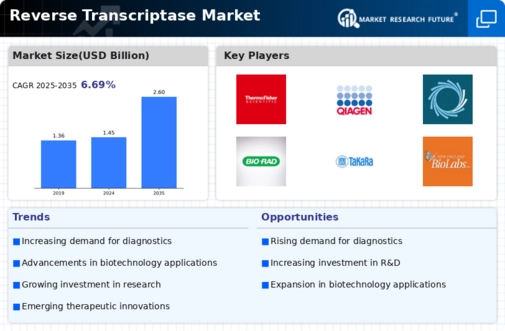Advancements in Biotechnology
Technological advancements in biotechnology are significantly influencing the Global Reverse Transcriptase Market Industry. Innovations in enzyme engineering and production processes have led to the development of more efficient and stable reverse transcriptases. These advancements enhance the performance of reverse transcriptase in various applications, including research and therapeutic development. As a result, the market is expected to grow at a CAGR of 5.45% from 2025 to 2035, potentially reaching 2.6 USD Billion by 2035. This growth trajectory indicates a robust interest in utilizing reverse transcriptase for novel biotechnological applications, including CRISPR and gene therapy.
Growing Applications in Therapeutics
The therapeutic applications of reverse transcriptase are expanding, contributing to the growth of the Global Reverse Transcriptase Market Industry. Reverse transcriptase is pivotal in the development of antiretroviral therapies for HIV and other RNA viruses. As the global burden of viral infections persists, the demand for effective treatments continues to rise. Furthermore, reverse transcriptase is being explored in the context of gene therapy and vaccine development, which could further enhance its market presence. The ongoing research and development in these areas suggest a promising future for reverse transcriptase applications in therapeutics.
Rising Research Activities in Genomics
The Global Reverse Transcriptase Market Industry is bolstered by the increasing research activities in genomics and transcriptomics. As researchers delve deeper into understanding gene expression and regulation, the demand for reverse transcriptase has surged. This enzyme is essential for synthesizing complementary DNA from RNA templates, facilitating various genomic studies. The global focus on genomics is reflected in funding initiatives and collaborations among academic institutions and biotech companies. Such investments are likely to sustain the market's growth, as they enable the development of advanced tools and methodologies that rely on reverse transcriptase.
Emerging Markets and Global Collaborations
Emerging markets are playing a crucial role in the expansion of the Global Reverse Transcriptase Market Industry. Countries in Asia-Pacific and Latin America are witnessing increased investments in biotechnology and healthcare infrastructure, leading to a growing demand for molecular biology tools, including reverse transcriptase. Additionally, global collaborations between research institutions and pharmaceutical companies are fostering innovation and accessibility to advanced technologies. This trend is likely to enhance the market's reach, as it allows for the sharing of knowledge and resources, ultimately driving the adoption of reverse transcriptase in various applications.
Increasing Demand for Molecular Diagnostics
The Global Reverse Transcriptase Market Industry is experiencing heightened demand for molecular diagnostics, driven by the need for accurate and rapid disease detection. This trend is particularly evident in the fields of oncology and infectious diseases, where reverse transcriptase plays a crucial role in the detection of RNA viruses and gene expression analysis. As healthcare systems globally prioritize early diagnosis and personalized medicine, the market is projected to reach 1.45 USD Billion in 2024. This growth reflects a broader shift towards molecular techniques in clinical laboratories, which are increasingly adopting reverse transcriptase for their diagnostic capabilities.

















